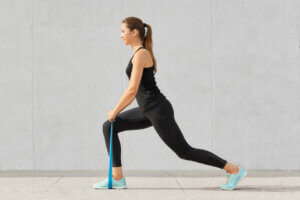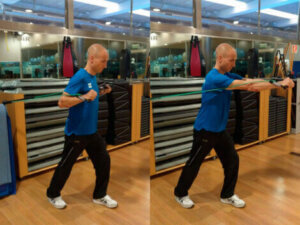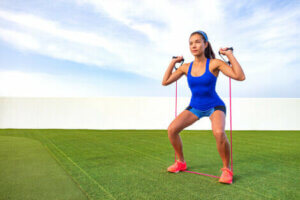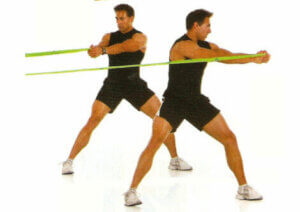Full Body Resistance Band Workout Routine

Resistance bands are a tool that many people use to work out from the comfort of their own homes. However, some of you might not be familiar with these handy pieces of kit. So, today, we want to show you a full-body resistance band workout routine. We’ll go through each exercise step-by-step so that you can try it out for yourself. Ready to get started?
Full-body resistance band workout routine
Sumo deadlift with resistance band
- Band placement: for this exercise, you’ll need to use your feet to hold the band firmly in place. To do this, lay the band flat on the ground and insert your feet into it, placing one foot at either end.
- Starting position: stand with your feet apart, so that they’re wider than the width of your shoulders. Keeping your spine in a neutral position, turn your feet outward slightly and bend your knees. Then, bring your hips forward so that they sit directly above your knees. Finally, grasp the band firmly, holding it in the center.
- Concentric phase: keeping your arms straight, flex your hips, pushing down with your legs until your knees are fully extended.
- Eccentric phase: return to the starting position in a steady and controlled manner. Try to maintain the same posture throughout.

Unilateral chest press with resistance band
- Band placement: attach the band to a bar or other stable surface to anchor it in place. For this exercise, it must be placed at chest height.
- Starting position: stand with your back to the bar you used to secure your resistance band. To increase your stability, place one foot slightly in front of the other. Hold the band so that your elbows are below shoulder height, keeping your arms at a 45-degree angle to your body. Don’t forget to keep your shoulders back (scapular retraction).
- Concentric phase: slowly push the band forward until your arms are almost fully extended, without locking your elbows. It’s important to make sure your core is engaged throughout the exercise.
- Eccentric phase: return to the starting position, slowly bending your elbows in a controlled manner.

Resistance band workout routine – the row
- Band placement: loop the band around a bar, placing it roughly at chest height. This will allow you to work both sides of your body at the same time.
- Starting position: holding the band at either end, face the bar, standing far enough away that the band is slightly taught. Good stability is particularly important for this exercise, as the tension of the band can easily cause you to overbalance. Place your feet shoulder-width apart, bend your knees, and tilt your hips slightly to engage your core. To begin the exercise, extend your arms, keeping them below shoulder height.
- Concentric phase: from the starting position, pull the band back toward your body. To do this, bring your elbows back until they’re behind you while keeping your arms at a 45-degree angle to your body.
- Eccentric phase: without losing the engagement of your core and shoulder blades, return to the starting position in a controlled manner.

Single-arm shoulder press with resistance bands
- Band placement: stand on the resistance band with one foot and grasp the other end with your hand on the same side.
- Starting position: raise your arm so that your wrist sits just above your shoulder.
- Concentric phase: extend your arm upward, without locking your elbow.
- Eccentric phase: return to the starting position in a slow and controlled manner, without letting the resistance band unbalance you.

Resistance band workout routine – the torso twist
- Band placement: loop the band around a bar, threading one end through the other, and pulling it tight to secure it. You should end up with a single loop or handle. For this exercise, the band should again be placed at chest height.
- Starting position: stand in front of the bar and hold the end of the band with both hands. It’s important to keep your eyes on the handle at all times. This will make it easier to perform this movement successfully.
- Concentric phase: this time, you’re going to twist your body from side to side. To do this, keep your arms straight, and twist your torso to bring your arms around to the other side of your body.
- Eccentric phase: return to the starting position in a controlled manner and without taking your eyes off the handle. Finally, repeat the movement on the opposite side.

Tips and advice
There are some important things you’ll need to bear in mind when trying out this full-body routine. Firstly, you’ll need to pay close attention to your breathing. As a general rule, try to exhale while performing the concentric phase of each exercise, while inhaling during the eccentric phase.
The number of sets and repetitions you include will largely depend on what you’re aiming to achieve. For example, your workout may include 3 or 4 sets of each exercise, with 8 – 12 repetitions, and rest or an active recovery period of one minute between each set.
You can use low-intensity exercises to create your own active recovery workout to go along with this routine.
It’s important to remember that everyone is different, and there are many factors to take into account when planning and personalizing your workout routine. One example might be the strength of the band you choose to use. If you’re ever in any doubt, we’d recommend consulting a professional.
Resistance bands are a tool that many people use to work out from the comfort of their own homes. However, some of you might not be familiar with these handy pieces of kit. So, today, we want to show you a full-body resistance band workout routine. We’ll go through each exercise step-by-step so that you can try it out for yourself. Ready to get started?
Full-body resistance band workout routine
Sumo deadlift with resistance band
- Band placement: for this exercise, you’ll need to use your feet to hold the band firmly in place. To do this, lay the band flat on the ground and insert your feet into it, placing one foot at either end.
- Starting position: stand with your feet apart, so that they’re wider than the width of your shoulders. Keeping your spine in a neutral position, turn your feet outward slightly and bend your knees. Then, bring your hips forward so that they sit directly above your knees. Finally, grasp the band firmly, holding it in the center.
- Concentric phase: keeping your arms straight, flex your hips, pushing down with your legs until your knees are fully extended.
- Eccentric phase: return to the starting position in a steady and controlled manner. Try to maintain the same posture throughout.

Unilateral chest press with resistance band
- Band placement: attach the band to a bar or other stable surface to anchor it in place. For this exercise, it must be placed at chest height.
- Starting position: stand with your back to the bar you used to secure your resistance band. To increase your stability, place one foot slightly in front of the other. Hold the band so that your elbows are below shoulder height, keeping your arms at a 45-degree angle to your body. Don’t forget to keep your shoulders back (scapular retraction).
- Concentric phase: slowly push the band forward until your arms are almost fully extended, without locking your elbows. It’s important to make sure your core is engaged throughout the exercise.
- Eccentric phase: return to the starting position, slowly bending your elbows in a controlled manner.

Resistance band workout routine – the row
- Band placement: loop the band around a bar, placing it roughly at chest height. This will allow you to work both sides of your body at the same time.
- Starting position: holding the band at either end, face the bar, standing far enough away that the band is slightly taught. Good stability is particularly important for this exercise, as the tension of the band can easily cause you to overbalance. Place your feet shoulder-width apart, bend your knees, and tilt your hips slightly to engage your core. To begin the exercise, extend your arms, keeping them below shoulder height.
- Concentric phase: from the starting position, pull the band back toward your body. To do this, bring your elbows back until they’re behind you while keeping your arms at a 45-degree angle to your body.
- Eccentric phase: without losing the engagement of your core and shoulder blades, return to the starting position in a controlled manner.

Single-arm shoulder press with resistance bands
- Band placement: stand on the resistance band with one foot and grasp the other end with your hand on the same side.
- Starting position: raise your arm so that your wrist sits just above your shoulder.
- Concentric phase: extend your arm upward, without locking your elbow.
- Eccentric phase: return to the starting position in a slow and controlled manner, without letting the resistance band unbalance you.

Resistance band workout routine – the torso twist
- Band placement: loop the band around a bar, threading one end through the other, and pulling it tight to secure it. You should end up with a single loop or handle. For this exercise, the band should again be placed at chest height.
- Starting position: stand in front of the bar and hold the end of the band with both hands. It’s important to keep your eyes on the handle at all times. This will make it easier to perform this movement successfully.
- Concentric phase: this time, you’re going to twist your body from side to side. To do this, keep your arms straight, and twist your torso to bring your arms around to the other side of your body.
- Eccentric phase: return to the starting position in a controlled manner and without taking your eyes off the handle. Finally, repeat the movement on the opposite side.

Tips and advice
There are some important things you’ll need to bear in mind when trying out this full-body routine. Firstly, you’ll need to pay close attention to your breathing. As a general rule, try to exhale while performing the concentric phase of each exercise, while inhaling during the eccentric phase.
The number of sets and repetitions you include will largely depend on what you’re aiming to achieve. For example, your workout may include 3 or 4 sets of each exercise, with 8 – 12 repetitions, and rest or an active recovery period of one minute between each set.
You can use low-intensity exercises to create your own active recovery workout to go along with this routine.
It’s important to remember that everyone is different, and there are many factors to take into account when planning and personalizing your workout routine. One example might be the strength of the band you choose to use. If you’re ever in any doubt, we’d recommend consulting a professional.
All cited sources were thoroughly reviewed by our team to ensure their quality, reliability, currency, and validity. The bibliography of this article was considered reliable and of academic or scientific accuracy.
- Wilson, J., & Kritz, M. (2015). Guía práctica y consideraciones para el uso de las bandas elásticas en el entrenamiento de la fuerza muscular. Entrenamiento de fuerza y acondicionamiento: Journal NSCA Spain, (1), 27-39.
- Baechle, T. R., & Earle, R. W. (Eds.). (2007). Principios del entrenamiento de la fuerza y del acondicionamiento físico. Ed. Médica Panamericana.
This text is provided for informational purposes only and does not replace consultation with a professional. If in doubt, consult your specialist.








